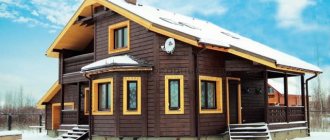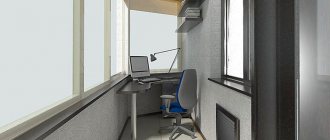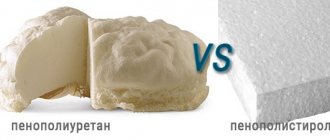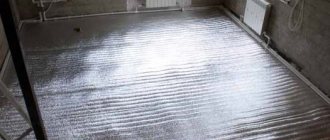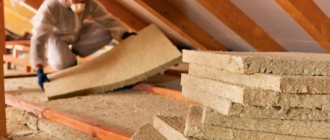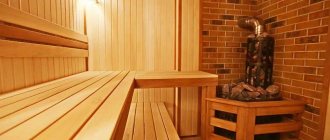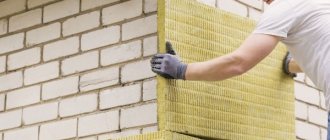Reflective insulation is a relatively new product. But soon one could see foil screens behind radiators and other heating devices. But this is only the visible part of the application. In fact, there is much greater potential hidden in isolation. How effective is this material, which Penofol is better to choose, how to use it correctly and which side to mount it on? About all this in our article!
Thermal insulation qualities of Penofol
It should be noted that when compressed to 2–3 times the original thickness, air is partially displaced from the material, and the thermal conductivity coefficient increases significantly.
At the same time, reducing the thickness of the layer leads to a proportional decrease in heat transfer resistance. This means, at least, that Penofol, as insulation, should not be used in a compressed state. On the manufacturer's website you can find the following values:
heat transfer resistance R of PENOFOL insulation in a structure with a closed air gap is 1.175 – 1.362 m2C/W.
Apparently, such a high value for a thin layer of insulation was obtained by adding up the heat transfer resistance of directly foamed polyethylene with a thickness of 5 - 10 mm - only 0.15 - 0.3 m2C / W, and also by adding here the heat saving from foil (a barrier for radiant heat), which completely depends on the radiation power from the inside, the temperature in the room, the presence of heating sources, the degree of absorption of radiation by structures, and also, apparently, adding the resistance of the “closed air gap” of the structure, which can actually reach 1.0 m2C/W, for example, in a double-glazed window.
However, the obvious fact is that Penofol really does insulate, all that remains is to apply it correctly.
Dew point
In other words, the dew point can be characterized as a parameter indicating the exact temperature threshold at which water begins to change its state of aggregation and becomes condensate.
To determine this parameter, use the following values:
- atmospheric pressure indicator;
- a value indicating the relative humidity of the air;
- actual temperature level in the atmosphere.
To identify a suitable parameter, starting from the last two values, you need to use the table from the appendix to SP 23-101-2004 “Design of thermal protection of buildings”.
The formula for calculating dew is given below:
Tr=b*f(TRh)/af(TRh), where Tr is the desired parameter, T (C o ) is temperature, Rh(%) is relative humidity.
Advantages and disadvantages
The main advantage of any insulation with a foil layer is its technical performance, which is significantly increased compared to similar materials, but without a foil layer. However, due to additional production costs and complicated technology, such a heat insulator is more expensive. In general, foil insulation has a lot of positive qualities.
Insulation with foil is significantly superior to conventional heat insulators
Advantages of the material:
- sound insulation;
- safety from an ecological point of view in most species;
- resistance to temperature changes;
- moisture resistance;
- easy installation;
- high thermal insulation properties;
- durability.
Pros and cons of foil insulation
The disadvantages of the material include softness, which prevents the use of foil insulation when laying some soft types of floor coverings, as well as high cost compared to ordinary thermal insulation materials.
Life time
Since foil insulation appeared relatively recently, it is not yet possible to determine the exact expiration date. However, after conducting experiments, we can say that the material does not lose its properties for 200 years.
The service life of the installed insulation depends on the adhesive used. If the adhesive composition has passed its expiration date, then you can re-install it with the same heat insulator.
There are a lot of insulation materials on the construction market. The choice is so wide that the question arises, which is better. To answer, you need to compare the characteristics of the thermal insulation material and the scope of application - street, living room, garage or agricultural building.
Advantages and disadvantages
Like any solution in the field of thermal insulation, penofol has certain advantages
They are the first thing consumers consider when looking for an effective insulator. Positive characteristics:
- The versatility of the material. It is actively used for work during the construction of facilities and during repairs. It is often used as the main insulation to improve the performance of balconies.
- Minimum thickness. Low values of this parameter do not affect the insulating properties in any way. For example, penofol with a double-sided foil coating 4 mm thick is an excellent replacement for an 8.5 cm mineral wool layer.
- Easy installation procedure. The absence of difficult moments during installation allows you to avoid purchasing special tools. To cut the fabric, you can use a regular knife. For reliable fastening, a regular furniture stapler, tape or small nails are suitable.
- Penofol is an environmentally friendly material. The components that are used to create it are often used for food storage. Some companies producing this solution claim that it is able to provide protection against radiation.
- High fire safety. This insulation will never cause a fire, since it is classified as a low-combustible material.
- Rodents are indifferent to this heat insulator.
- Ease of transportation. Penofol is produced in the form of rolls. They are easy to place even in the luggage compartment of a car.
Although penofol has many advantages, it is still not without its disadvantages. One of them is excessive softness. This feature imposes certain restrictions on use: the material cannot be used for thermal insulation of walls under plaster or wallpaper; in some cases, a special adhesive composition is required for fastening (this disadvantage is absent if the consumer has chosen self-adhesive insulation for the work).
Nuances of foam installation technology
Thermal insulation construction with penofol provides a preparatory stage and selection of the necessary tools. The condition of communications and the structure itself is first checked. If there are grooves or other defects on the base, they need to be repaired with putty. There should be no dust or dirt on the surface. It is thoroughly cleaned with sandpaper.
Tools and materials
To insulate a structure with the specified material, the following tools are required:
- building level, knife, tape measure;
- stapler and staples;
- spatulas;
- marker;
- electric drill;
- screwdriver;
- sandpaper.
Dowels are often used to secure the material. During preparation, a primer must also be applied to the base. If the base is wooden, then it requires additional antiseptic and fire retardant treatment.
Insulation of house walls from the inside
Insulation of walls from the inside is carried out in the following order:
- Making a frame from wooden slats. In this case, a space of 2 cm should remain on both sides of the penofol. Thus, the effect of the insulation will be maximum. The sheathing must be secured using dowels. The pitch between the slats is 1 m.
- Insulation of electrical wires. The aluminum foam layer has a high level of electrical conductivity.
- Fastening the material. A furniture stapler and staples are used for fixation. Strips of the required width or length are cut with a construction knife. To improve the thermal insulation properties, the seams between the elements are taped with masking tape. It is not recommended to lay strips overlapping.
After the insulation is secured, the wooden frame is reinstalled. Chipboard or MDF can be fixed on it for subsequent finishing.
External wall insulation
To insulate a house from the outside, it is better to use a perforated type of material. It not only provides good insulating properties, but also helps remove steam from the room. Exterior finishing is done if there is no desire to change anything inside the building. Work should be carried out in warm weather on a dry base. Installation involves the following steps:
- Treating walls with antiseptic.
- Making a wooden frame. Self-tapping screws are used for fastening.
- Laying the insulation while maintaining a two-sided gap of 2 cm. The joints are connected with metallized tape.
Now you can make another wooden frame and begin finishing the building.
Ceiling insulation
Installation of insulation on the ceiling is carried out in the following sequence:
- Fastening the frame from wooden planks or metal profiles. Dowels are used for fixation. The step between elements is 1 m.
- Preparation of penofol fragments. There is no need to cut a large number of strips at once, since the ceiling area may have deviations.
- Fastening the material. The first strip is nailed onto the frame close to the wall. In this case, the foil side should be facing inside the room.
- The remaining fragments of penofol are laid end to end. All seams are covered with foil tape.
Chipboard sheets can be mounted on top of the material and the surface can be finished.
Floor insulation
Penofol is used as an insulating layer when arranging floors, as it is unpretentious in installation and operation. The base does not require special preparation. It needs to be smooth, clean and dry. The insulation must be laid so that there is a ventilation gap between the surface and the material. This will make it possible to avoid condensation.
Penofol must be secured with glue or double-sided tape. The use of a construction stapler is permitted. As in previous cases, the insulation strips are mounted end-to-end, and the seams are connected with metallized tape. The foil should “look” inside the rooms.
So, penofol is a new generation of insulation that provides a high level of insulation not only from heat loss, but also from noise and moisture. At the same time, the material consumption is relatively small. However, you need to choose the material correctly.
Choice
It is necessary to first determine the main goals of insulation.
To perform insulation quickly, without difficulty, you will need rolled raw materials with a thickness of at least 5 mm.
Work in rooms with high levels of humidity and periodic temperature fluctuations is obtained better when using foil-clad polypropylene.
Regardless of the type of penofol, you need to carefully check it. It is not recommended to take stitched rolls or poorly polished foil. Poor quality raw materials will have consequences.
You need to consider packaging with a footage of 9-18 square meters. m, produced by well-known, well-established brands. If you cannot find such information on your own, you need to contact master builders for advice. Experts do not advise contacting store consultants with such questions, as they strive to sell a specific product, and not the best.
Penofol pros and cons
Insulation with penofol is easier to perform, and due to its smaller thickness and high thermal insulation characteristics, the material has received many positive reviews from users.
What is penofol?
Penofol is know-how in the world of materials for insulating wooden houses, loggias and baths. It refers to reflective insulation with a top layer of special polished foil material. The base is foamed PVC. The heat-saving properties of the material depend on the density, thickness and quality of the foam base. The foam base has a thickness from 2 to 40 mm. The most common for insulating a wooden house inside is 10 mm. The 40 mm material is used only in the northern part of Russia, where the climate is very harsh. On top (on both or one side) foil is welded to the material, which is polished to a reflectivity of 97%.
A little bit of history
The material was invented in the USA and was used to produce spacesuits
In Russia, they paid attention to the high thermal insulation properties of the material and began to use it in the construction industry. For insulation of wooden houses, the material is used both inside and outside.
Insulating a wooden house from the inside with penofol is similar in design to a thermos. A wooden house, the walls of which are covered with foil thermal insulation, retains heat in winter and cool air in it in summer. At the same time, the internal insulation does not block the supply of oxygen to the tree, and the house does not stop breathing. And the thickness is several tens of times smaller than mineral wool or polystyrene foam, which made it possible to use insulation in the smallest rooms.
About the advantages and disadvantages of the material
Insulation can be used in combination with other materials or independently. And its lightness allows you to easily carry out insulation with your own hands alone. Positive reviews about penofol insulation are associated with its advantages:
- Environmentally friendly. The material is made of film and foil, which are used in the food industry. Some sources claim that it is capable of blocking radiation, but this fact has not been proven.
- Greater thermal insulation with a smaller layer thickness. According to scientific research, penofol with double-sided foil 4 mm thick is comparable in its thermal insulation properties to 10 cm mineral wool, 4 cm expanded polystyrene and 18 mm wood.
- Since the material does not allow steam to pass through, installation can be carried out without additional thermal insulation of the structure.
- It does not allow moisture to pass through or absorb, therefore it does not spread rot and mold on the wood.
- It has high soundproofing qualities, so it is used in frame construction for finishing children's rooms and bedrooms.
- It does not crumble or break; you can cut it with simple scissors or a sharp knife.
- Easily mounted on wooden walls of the house using small nails, construction foil tape or a stapler.
- It does not burn, as it has a fire hazard class that is difficult to combust and difficult to ignite.
- You can transport the material alone in any passenger car. It is lightweight and rolls into a soft roll.
- Due to the thin layer, rodents will not make burrows in the material, as, for example, in polystyrene foam or mineral wool.
- Certified by specialists of the Sanitary and Epidemiological Institute, and suitable for use in children's institutions.
Despite all the advantages, there are many negative reviews about the material. They are associated with the following qualities:
- Softness. After installation, the inside of a wooden house cannot be immediately plastered or wallpapered.
- It is difficult to install using special glue, and using nails or a stapler, the material breaks through and loses part of its thermal insulation. You can only exclude group C, which includes insulation on one side covered with an adhesive composition, like adhesive tape.
- It should not be used for facade insulation, as the material will not release steam from the house and condensation will accumulate under the film. This will quickly destroy the walls.
With high-quality installation and proper insulation, Pefonol insulation provides long-term protection to the walls, floors and ceiling of a wooden house. For each part of the structure, a certain grade of material is used.
Thermal insulation of wooden walls with Penofol
Work on insulating a wooden house is carried out according to the following algorithm:
Insulation of wooden walls from the inside with Penofol should begin with sealing the cracks and gaps that form naturally in the wood
It is recommended to pay special attention to checking joints, window frames, door frames, and corners. Making a frame for a heat insulator for wooden walls is not necessary. If sheet Penofol with one-sided foil is used, then it is the side with foil that should be facing the sheathing, that is, inside the room. A sharp knife is used to cut strips
The strips are attached using special staples and a powerful construction stapler. At the same time, they should be in close contact with each other so that there is no free space between them. To secure the joints, they are glued with aluminum tape. This will provide a smooth and uniform reflective surface. Maintaining an air gap is a mandatory factor for effective insulation and the absence of condensation. The air space must pass between the material and the wall. Wooden blocks are placed on top of the insulator, which will serve as lathing. You can attach chipboard sheets or plastic panels to them. Final finishing occurs in the same way as in the case of concrete walls.
Note! It is necessary to carry out work on the internal insulation of a wooden house after the final shrinkage of its walls and foundation occurs. Usually this happens no earlier than a year after completion of all construction work.
What is Penofol and its analogues
Thin polymer insulation is made from the following materials:
- The main insulating layer is foamed polyethylene 3...10 mm thick with closed air pores. The thermal conductivity coefficient λ of this layer lies in the range of 0.037–0.051 W/(m • °C) depending on operating conditions.
- The outer reflective layer is aluminum foil 14 microns thick, securely glued to a polymer base.
- The third layer on the back side of the polyethylene can be glue for ease of installation or the same aluminum.
A special feature of the material is its impermeability to moisture, the declared indicator is simply scanty - 0.001 mg/m • h • Pa. The insulation is quite light - the density ranges from 16...35 kg/m³, and is sold in rolls. Thanks to these parameters, the material serves well as an internal vapor barrier.
"Penofol" is available in 3 versions:
- double layer type A;
- three-layer – the base is coated with aluminum on both sides (type B);
- the same, with an adhesive layer - Type C.
The foil side works as a reflector of the radiant (infrared) component, polyethylene foam resists direct heat transfer. For exterior wall cladding, a perforated version of Penofol, shown in the photo, is offered. Many small holes are designed to allow water vapor to escape from the thickness of building structures.
External wall cladding is made with special insulation with perforation
Step-by-step instructions for insulating a loggia with your own hands
To successfully insulate a balcony with your own hands using penofol, follow these instructions:
- Fix the penoplex to the wall using screws with a wide head on one side.
- The rolled material is cut and placed next to each other so that the joints coincide in the vertical direction. If necessary, you can move each sheet slightly.
- The cracks are treated with polyurethane foam.
- When the foam dries, armed with screws, secure the penofol.
- If only one side is covered with foil, position the material so that the shiny surface is inside the loggia.
- Proceed with the installation of the sheathing on which you need to fix the sheathing material. The best is considered to be a lathing equipped with slats, providing a plane between the penofol and the decorative cladding.
Nuances of fastening and installation
When laying foil insulation, you may need the following tools and materials:
- nails with large heads;
- stapler;
- hammer;
- construction tape.
When installing insulation with foil, it is important to avoid the mistake of laying the material with the shiny side down. In this case, the material will not perform its heat-reflecting functions.
The foil side must “look” into the room in order to be able to return thermal energy to the room.
An example of laying lag on foil insulation
It is also important to remember that the insulation does not overlap. The sheets should be placed end to end and secured with tape or nails, depending on the type of base
Insulation with an adhesive layer may not be additionally fixed, but it is still recommended to secure it with fastening materials. All joints after laying the material are taped.
Thermal insulation for heated floors
Work on laying insulation can be dry or wet. In the second case, the material will be filled with concrete screed. In the first one, it is advisable to install an additional waterproofing layer.
Application area
Thermal insulation with foil comes in several types and all of them are combined products. Thanks to this, the material has a very wide application area.
Products with foiled mineral wool can be used in different rooms. They can insulate hot and cold water supply pipes, and also perform:
- insulation of ventilation shafts and air ducts;
- insulation of the ceiling and the inside of the roof;
- thermal insulation of walls from the inside and outside;
- linoleum backing;
- insulation of wells and boreholes.
It is used when installing “warm floors”. A layer of foil reflects heat and directs it in the right direction. In small rooms, foil insulation will be a salvation, because... the already small size of the room will not decrease even more. A thin layer of material will be appropriate for low ceilings. For example, you can even put 2 layers of insulation on the attic and roof without losing height.
Foil material is suitable for arranging baths and saunas. There, heating does not occur constantly, and it is not advisable to spend money on expensive materials.
Garages, hangars, and outbuildings do not require expensive insulation. Walls insulated with foil material and an installed radiator or potbelly stove will be quite sufficient for a comfortable stay in such rooms.
Kinds
Depending on the intended use of the material, manufacturers produce the following types:
- type A, covered with foil on one side only. It is also called one-sided;
- type B, presented in the form of double-sided foil coating. Used for autonomous type of insulation;
- type C, self-adhesive penofol, which at its base consists of foil, polyethylene and a layer of moisture-resistant glue. This option is convenient for installation and does not require additional installation tools.
In addition to the three main types, manufacturers also produce the following options:
- ALP type, which is additionally covered with polyethylene film. This film is designed to protect the material from aggressive environments;
- type M and R, presented in the form of one-sided insulation with a relief base;
- type AIR, special materials used to install air vents.
Foil for underfloor heating
This material is used quite often when installing heated floors. It allows you to reduce heat loss during the use of the heating system, which makes it possible to save money spent on heating or electricity bills. Materials with a foil surface are considered the most effective in terms of energy saving.
Foil for underfloor heating
However, all of the above properties are possessed not only by the foil itself, but also by the materials on the surface of which it is glued during production. There are several main groups of thermal insulation materials that can have a foil layer.
Foil insulator for heated floors
Properties and characteristics of penofol
Operating principle
The photo shows a roll of one-sided foam foam used for interior work.
Penofol is a combined material consisting of foamed polyethylene and purified foil with a high reflectivity of infrared waves.
The operating principle of the material is based on complex resistance to the processes of thermal energy propagation.
As you know, there are three ways to distribute heat:
- convection,
- direct heat transfer,
- and radiation.
Most isolators prevent any one of these methods.
Penofol is able to create a barrier to direct heat transfer due to a layer of foamed polyethylene, which has in its structure many sealed pores filled with air or carbon dioxide. Thus, heat transfer through this layer is difficult. Most insulation materials, such as polystyrene foam, mineral wool or polyurethane foam, work on the same principle.
In addition, our insulation has a layer of reflective foil. It is applied to polyethylene by thermal welding and has a reflection coefficient of at least 97%. It should be said that ordinary foil has a reflection coefficient of 50 - 70%.
The foil used in the production of penofol has a thickness of 20 - 30 microns. Polyethylene foam can have different thicknesses, from 2 to 10 mm. Sometimes thicknesses reaching up to 40 mm are used, but this is rare.
So, we get a material that resists not only direct heat transfer, but also prevents the penetration of infrared thermal radiation outside the room, reflecting them inside
In addition, penofol has excellent soundproofing and vapor barrier properties, which is also important and saves money on additional materials
The price of the material fluctuates in the middle and lower ranges, significantly inferior to the cost of many modern insulation materials, such as polyurethane foam. Installation work can be easily done with your own hands without the involvement of specialists, which also saves money.
Application area
The scope of application of penofol is so wide that it can be found in the most unexpected places.
Penofol is used for insulation:
- Residential buildings: light and country buildings, cottages, private houses, multi-storey buildings;
- Sauna, baths;
- Industrial and administrative buildings;
- Medical institutions, kindergartens;
- Warehouses, hangars, both heated and cold;
- Capital and temporary trade pavilions, shops, supermarkets and shopping and entertainment centers;
- Refrigeration chambers;
- Pipelines for various purposes;
- Heating, air conditioning, ventilation and water supply systems;
- Cars, railway cars, vans, refrigerators.
It is possible to process the following structures:
- External and internal walls;
- Ceilings;
- Roof insulation;
- Ceilings over cold basements;
- Floors.
Characteristics
Hoods treated with reflective insulation.
Penofol has the following characteristics:
- Heat transfer resistance for double-sided material with a thickness of 4 and 5 mm is 1.2 – 1.23 m²×°C/W. Mineral wool insulation has similar properties with a thickness of 85 mm;
- Vapor permeability less than 0.001 mg/m×h×Pa;
- Sound absorption of at least 32 dB;
- Works to protect against acoustic and structural noise, as it is installed on top of the frame elements;
- The reflection coefficient of waves in the infrared range of electromagnetic radiation is no less than 97%.
With all these qualities, penofol is a thin, flexible, light and soft material, the installation of which is simplified as much as possible. It is also easy to transport, and storage is carried out in convenient rolls. By all indicators, this is a new generation material.
Useful video
Various building materials are used to insulate residential and non-residential buildings. Penofol is also used as insulation. Let's consider what this material is, what its advantages and disadvantages are.
Tepofol NPE “S” Self-adhesive – Foil / Metallized
| Name | Thickness | Dimensions | Square | Photo | Price per m2 |
| Tepofol 3mm foil self-adhesive | 3mm | 1mx25m | 25m2 | Photo | 87 |
| Tepofol 4mm foil self-adhesive | 4mm | 1mx25m | 25m2 | Photo | 90 |
| Tepofol 5mm foil self-adhesive | 5mm | 1mx25m | 25m2 | Photo | 95 |
| Tepofol 8mm foil self-adhesive | 8mm | 1mx25m | 25m2 | Photo | 105 |
| Tepofol 10mm foil self-adhesive | 10mm | 1mx25m | 25m2 | Photo | 115 |
| Tepofol 15mm foil self-adhesive | 15mm | 1mx25m | 25m2 | Photo | 180 |
| Tepofol 20mm foil self-adhesive | 20mm | 1mx25m | 25m2 | Photo | 190 |
| Tepofol 25mm foil self-adhesive | 25mm | 1mx2m | 2m2 | Photo | 265 |
| Tepofol 30mm foil self-adhesive | 30mm | 1mx2m | 2m2 | Photo | 245 |
| Tepofol 40mm foil self-adhesive | 40mm | 1mx2m | 2m2 | Photo | 300 |
| Tepofol 50mm foil self-adhesive | 50mm | 1mx2m | 2m2 | Photo | 360 |
Penofol pros and cons
Insulation with penofol is easier to perform, and due to its smaller thickness and high thermal insulation characteristics, the material has received many positive reviews from users.
What is penofol?
Penofol is know-how in the world of materials for insulating wooden houses, loggias and baths. It refers to reflective insulation with a top layer of special polished foil material. The base is foamed PVC. The heat-saving properties of the material depend on the density, thickness and quality of the foam base. The foam base has a thickness from 2 to 40 mm. The most common for insulating a wooden house inside is 10 mm. The 40 mm material is used only in the northern part of Russia, where the climate is very harsh. On top (on both or one side) foil is welded to the material, which is polished to a reflectivity of 97%.
A little bit of history
The material was invented in the USA and was used to produce spacesuits
In Russia, they paid attention to the high thermal insulation properties of the material and began to use it in the construction industry. For insulation of wooden houses, the material is used both inside and outside.
Insulating a wooden house from the inside with penofol is similar in design to a thermos. A wooden house whose walls are covered with foil thermal insulation retains heat in winter and cool air in it in summer. At the same time, the internal insulation does not block the supply of oxygen to the tree and the house does not stop breathing. And the thickness is several tens of times smaller than mineral wool or polystyrene foam, which made it possible to use insulation in the smallest rooms.
About the advantages and disadvantages of the material
Insulation can be used in combination with other materials or independently. And its lightness allows you to easily carry out insulation with your own hands alone. Positive reviews about penofol insulation are associated with its advantages:
- Environmentally friendly. The material is made of film and foil which are used in the food industry. Some sources claim that it is capable of not letting radiation through, but this fact has not been proven.
- Greater thermal insulation with a smaller layer thickness. According to scientific research, penofol with double-sided foil 4 mm thick is comparable in its thermal insulation properties to 10 cm mineral wool, 4 cm polystyrene foam and 18 mm wood.
- Since the material does not allow steam to pass through, installation can be carried out without additional thermal insulation of the structure.
- It does not allow moisture to pass through or absorb, therefore it does not spread rot and mold on the wood.
- It has high soundproofing qualities, so it is used in frame construction for finishing children's rooms and bedrooms.
- It does not crumble or break; it can be cut with simple scissors or a sharp knife.
- Easily mounted on wooden walls of the house using small nails, construction foil tape or a stapler.
- It does not burn, as it has a fire hazard class that is difficult to combust and difficult to ignite.
- You can transport the material alone in any passenger car. It is lightweight and rolls into a soft roll.
- Due to the thin layer, rodents will not make burrows in the material, as, for example, in polystyrene foam or mineral wool.
- Certified by specialists of the Sanitary and Epidemiological Institute, and suitable for use in children's institutions.
How to calculate the thickness of penoplex for high-quality insulation
In order to accurately determine the required thickness of extruded polystyrene foam, you should take into account the material of the wall that needs to be insulated, its thickness, and the features of the finishing.
Thermal resistance is calculated. The data is determined based on SNiP readings for a specific region. So, for the central region this figure is close to 3.
The thermal resistance of each layer of the cake is different, so it is determined by adding the indicators of each layer and their thickness.
According to the formula, the thermal conductivity coefficient is determined as follows:
P=R/K, where R is the layer thickness, K is thermal conductivity.
Each material has its own thermal conductivity.
Calculation of penoplex thickness
After determining the values of the coefficients of all layers from the regional indicator (in our case it is equal to 3), the sum of all coefficients should be subtracted. This results in the thickness of the insulation layer.
IMPORTANT! As a rule, penoplex up to 30 mm thick is used for internal thermal insulation.
The manufacturer recommends using “Wall” penoplex for interior finishing.

